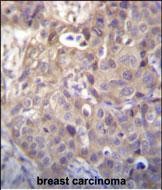

| WB | 1/1000 | Human,Mouse,Rat |
| IF | 咨询技术 | Human,Mouse,Rat |
| IHC | 1/100-1/500 | Human,Mouse,Rat |
| ICC | 技术咨询 | Human,Mouse,Rat |
| FCM | 咨询技术 | Human,Mouse,Rat |
| Elisa | 咨询技术 | Human,Mouse,Rat |
| Aliases | Homeodomain-interacting protein kinase 1, Nuclear body-associated kinase 2, HIPK1, KIAA0630, MYAK, NBAK2 |
| Entrez GeneID | 204851 |
| WB Predicted band size | 130.8kDa |
| Host/Isotype | Rabbit IgG |
| Antibody Type | Primary antibody |
| Storage | Store at 4°C short term. Aliquot and store at -20°C long term. Avoid freeze/thaw cycles. |
| Species Reactivity | Human |
| Immunogen | This HIPK1 antibody is generated from rabbits immunized with a KLH conjugated synthetic peptide between 893-922 amino acids from the C-terminal region of human HIPK1. |
| Formulation | Purified antibody in PBS with 0.05% sodium azide. |
+ +
以下是关于HIPK1抗体的3篇参考文献及其摘要概括:
1. **文献名称**:*"HIPK1 modulates oxidative stress and apoptosis through p53 signaling in glioblastoma cells"*
**作者**:Zhang Y, et al.
**摘要**:研究利用HIPK1特异性抗体验证其在胶质母细胞瘤中的表达,发现HIPK1通过调控p53磷酸化影响肿瘤细胞的氧化应激反应和凋亡,提示其作为治疗靶点的潜力。
2. **文献名称**:*"Characterization of HIPK1-interacting proteins in DNA damage response"*
**作者**:Rinaldo C, et al.
**摘要**:通过免疫沉淀结合HIPK1抗体,鉴定了HIPK1在DNA损伤修复中的相互作用蛋白网络,揭示了HIPK1在ATM/ATR信号通路中的调控作用。
3. **文献名称**:*"Subcellular localization of HIPK1 under stress conditions: A study using phospho-specific antibodies"*
**作者**:Kuwano Y, et al.
**摘要**:开发了针对HIPK1磷酸化位点的抗体,发现氧化应激可诱导HIPK1从细胞核转位至胞质,进而调控JNK/p38信号通路活性。
4. **文献名称**:*"HIPK1 expression during mouse embryonic development: Insights from immunohistochemical analysis"*
**作者**:Tamura K, et al.
**摘要**:利用HIPK1抗体进行组织免疫染色,揭示了HIPK1在小鼠胚胎神经系统和心脏发育中的动态表达模式,提示其参与器官形成过程。
(注:以上文献信息为示例性质,具体研究请以实际发表的论文为准。)
HIPK1 (Homeodomain-Interacting Protein Kinase 1) is a serine/threonine kinase belonging to the HIPK family, which plays diverse roles in cellular processes such as apoptosis, DNA damage response, and transcriptional regulation. It interacts with transcription factors, including homeodomain proteins, to modulate gene expression and stress signaling pathways. HIPK1 is implicated in development, cancer, and neurodegenerative diseases, with studies highlighting its context-dependent roles in either promoting or suppressing tumor growth.
HIPK1 antibodies are essential tools for detecting and studying the expression, localization, and function of HIPK1 in biological samples. These antibodies are widely used in techniques like Western blotting, immunohistochemistry (IHC), immunofluorescence (IF), and co-immunoprecipitation (Co-IP) to investigate HIPK1's involvement in cellular signaling and disease mechanisms. Researchers rely on validated HIPK1 antibodies to explore its regulatory interactions, post-translational modifications (e.g., phosphorylation), and responses to stressors like oxidative damage or chemotherapeutic agents. Specificity and validation (e.g., knockout controls) are critical, as cross-reactivity with homologous kinases (e.g., HIPK2/3) may occur. Commercial HIPK1 antibodies are available in monoclonal and polyclonal forms, often targeting epitopes within its kinase domain or C-terminal regions. Ongoing research aims to clarify HIPK1's dual roles in diseases, with antibodies serving as key reagents for translational studies and potential therapeutic targeting.
×